Marketing Mix Report: Analysis of an NGO's Strategies
VerifiedAdded on 2019/09/18
|13
|3070
|282
Report
AI Summary
This report provides a comprehensive analysis of the marketing mix model within a non-governmental organization (NGO) context. The report begins with a brief overview of the organization and its mission, followed by a detailed explanation of the four elements of the marketing mix: product, price, place, and promotion. Each element is examined in relation to the NGO's services, including training, coaching, and mentoring. The report highlights the challenges associated with promotion, particularly the rising costs of traditional advertising. It then proposes web-based advertising as a cost-effective solution, discussing its advantages and implications based on SMART factors. The report also addresses the importance of performance measurement, identifies associated problems, and suggests solutions to improve outcome assessment. Overall, the report offers valuable insights into the application of marketing strategies within a non-profit setting, emphasizing the importance of adapting to changing market dynamics and leveraging online platforms for effective communication and outreach.

Word count: 2542 words (including the Table contents, Table of
figure and report)
figure and report)
Paraphrase This Document
Need a fresh take? Get an instant paraphrase of this document with our AI Paraphraser
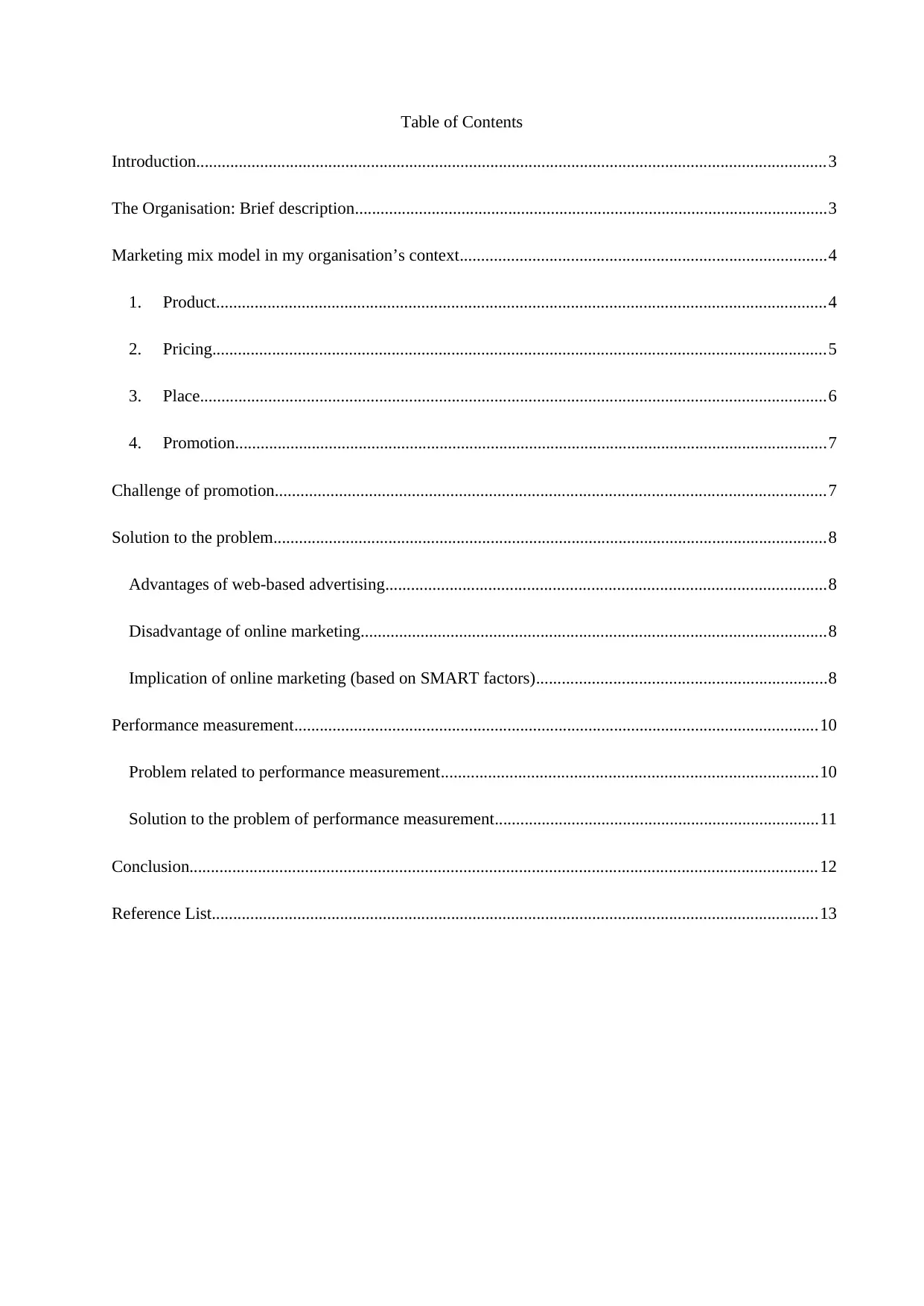
Table of Contents
Introduction....................................................................................................................................................3
The Organisation: Brief description...............................................................................................................3
Marketing mix model in my organisation’s context......................................................................................4
1. Product...............................................................................................................................................4
2. Pricing................................................................................................................................................5
3. Place...................................................................................................................................................6
4. Promotion...........................................................................................................................................7
Challenge of promotion.................................................................................................................................7
Solution to the problem..................................................................................................................................8
Advantages of web-based advertising.......................................................................................................8
Disadvantage of online marketing.............................................................................................................8
Implication of online marketing (based on SMART factors)....................................................................8
Performance measurement...........................................................................................................................10
Problem related to performance measurement........................................................................................10
Solution to the problem of performance measurement............................................................................11
Conclusion...................................................................................................................................................12
Reference List..............................................................................................................................................13
Introduction....................................................................................................................................................3
The Organisation: Brief description...............................................................................................................3
Marketing mix model in my organisation’s context......................................................................................4
1. Product...............................................................................................................................................4
2. Pricing................................................................................................................................................5
3. Place...................................................................................................................................................6
4. Promotion...........................................................................................................................................7
Challenge of promotion.................................................................................................................................7
Solution to the problem..................................................................................................................................8
Advantages of web-based advertising.......................................................................................................8
Disadvantage of online marketing.............................................................................................................8
Implication of online marketing (based on SMART factors)....................................................................8
Performance measurement...........................................................................................................................10
Problem related to performance measurement........................................................................................10
Solution to the problem of performance measurement............................................................................11
Conclusion...................................................................................................................................................12
Reference List..............................................................................................................................................13
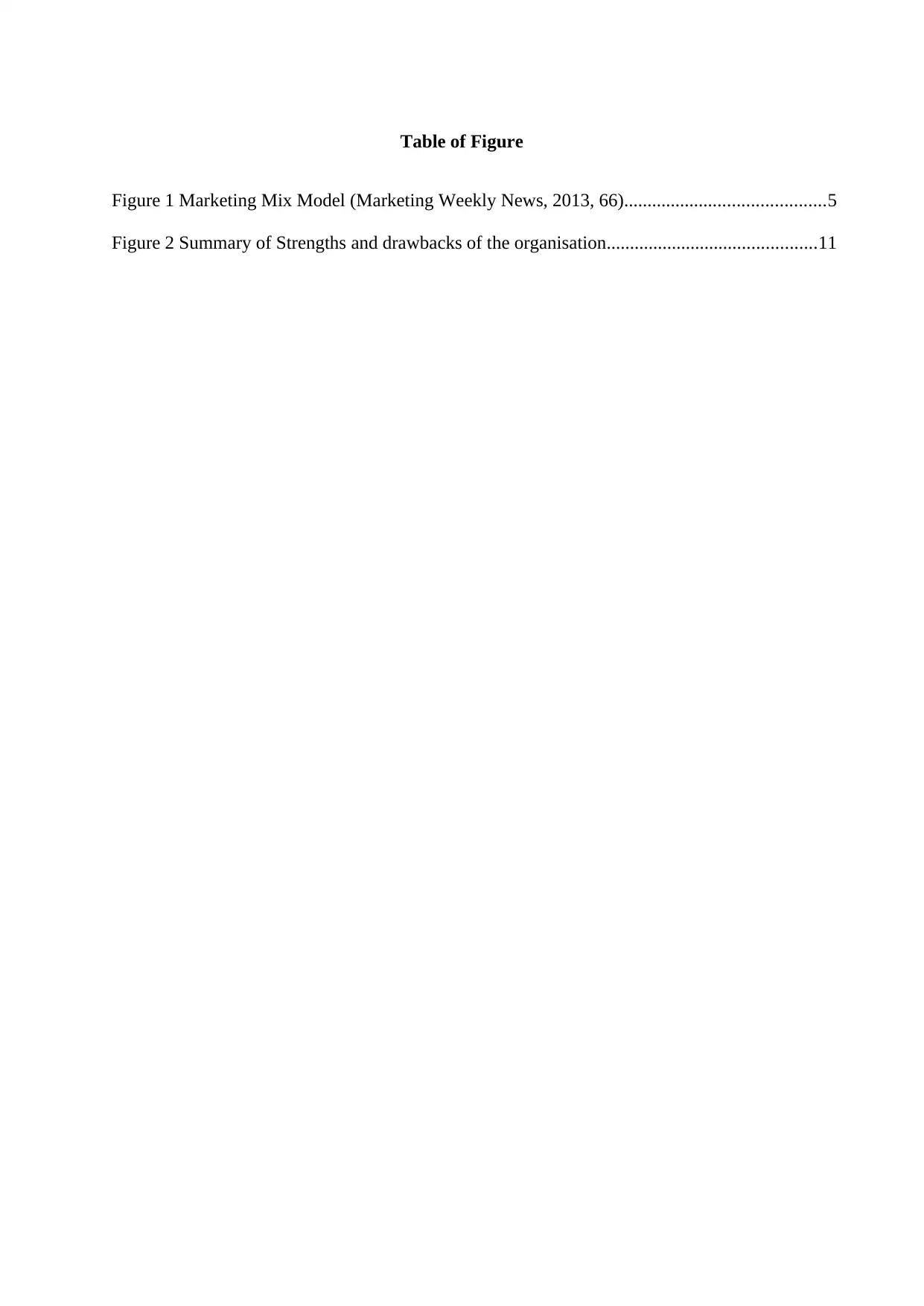
Table of Figure
Figure 1 Marketing Mix Model (Marketing Weekly News, 2013, 66)...........................................5
Figure 2 Summary of Strengths and drawbacks of the organisation.............................................11
Figure 1 Marketing Mix Model (Marketing Weekly News, 2013, 66)...........................................5
Figure 2 Summary of Strengths and drawbacks of the organisation.............................................11
⊘ This is a preview!⊘
Do you want full access?
Subscribe today to unlock all pages.

Trusted by 1+ million students worldwide
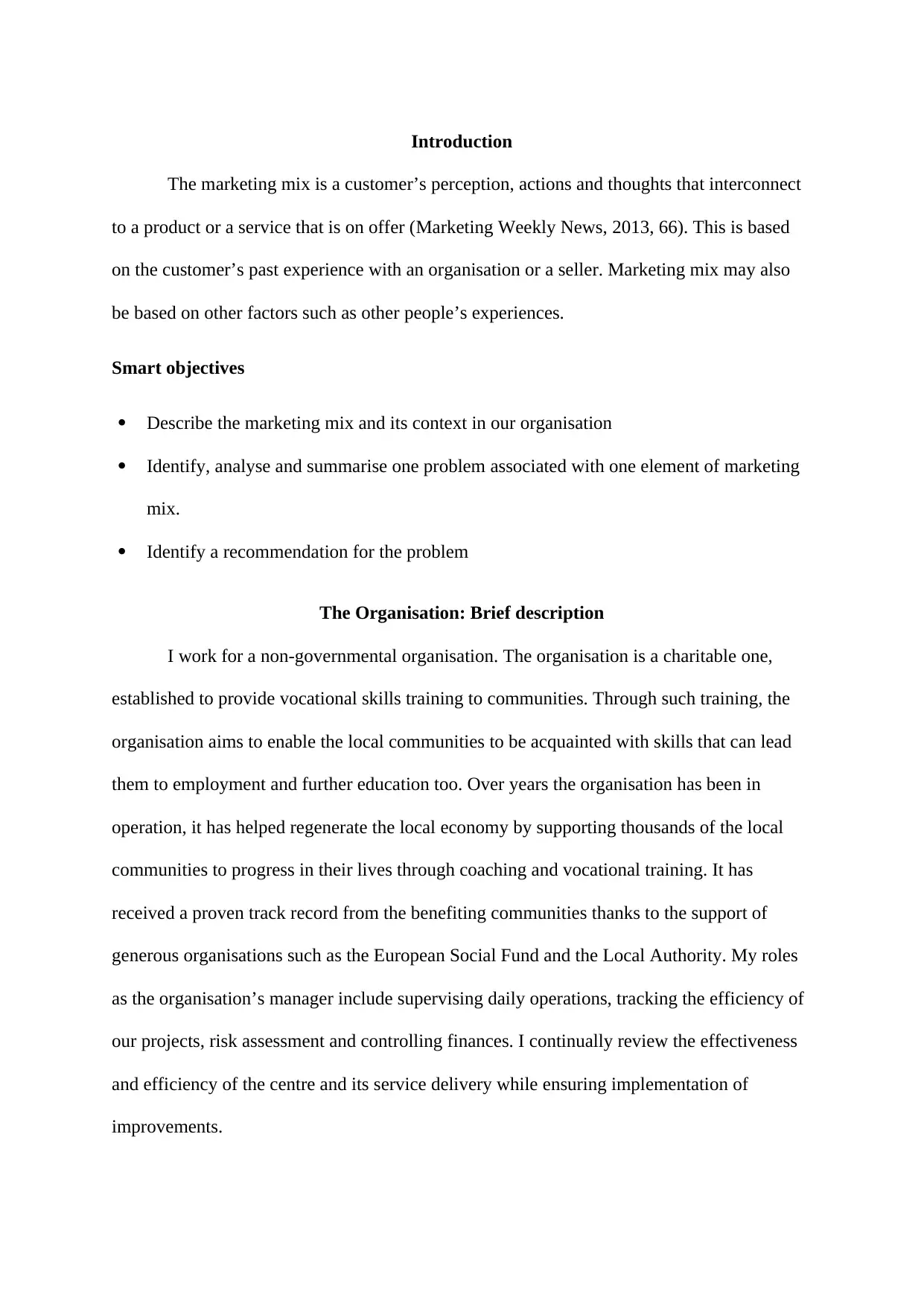
Introduction
The marketing mix is a customer’s perception, actions and thoughts that interconnect
to a product or a service that is on offer (Marketing Weekly News, 2013, 66). This is based
on the customer’s past experience with an organisation or a seller. Marketing mix may also
be based on other factors such as other people’s experiences.
Smart objectives
Describe the marketing mix and its context in our organisation
Identify, analyse and summarise one problem associated with one element of marketing
mix.
Identify a recommendation for the problem
The Organisation: Brief description
I work for a non-governmental organisation. The organisation is a charitable one,
established to provide vocational skills training to communities. Through such training, the
organisation aims to enable the local communities to be acquainted with skills that can lead
them to employment and further education too. Over years the organisation has been in
operation, it has helped regenerate the local economy by supporting thousands of the local
communities to progress in their lives through coaching and vocational training. It has
received a proven track record from the benefiting communities thanks to the support of
generous organisations such as the European Social Fund and the Local Authority. My roles
as the organisation’s manager include supervising daily operations, tracking the efficiency of
our projects, risk assessment and controlling finances. I continually review the effectiveness
and efficiency of the centre and its service delivery while ensuring implementation of
improvements.
The marketing mix is a customer’s perception, actions and thoughts that interconnect
to a product or a service that is on offer (Marketing Weekly News, 2013, 66). This is based
on the customer’s past experience with an organisation or a seller. Marketing mix may also
be based on other factors such as other people’s experiences.
Smart objectives
Describe the marketing mix and its context in our organisation
Identify, analyse and summarise one problem associated with one element of marketing
mix.
Identify a recommendation for the problem
The Organisation: Brief description
I work for a non-governmental organisation. The organisation is a charitable one,
established to provide vocational skills training to communities. Through such training, the
organisation aims to enable the local communities to be acquainted with skills that can lead
them to employment and further education too. Over years the organisation has been in
operation, it has helped regenerate the local economy by supporting thousands of the local
communities to progress in their lives through coaching and vocational training. It has
received a proven track record from the benefiting communities thanks to the support of
generous organisations such as the European Social Fund and the Local Authority. My roles
as the organisation’s manager include supervising daily operations, tracking the efficiency of
our projects, risk assessment and controlling finances. I continually review the effectiveness
and efficiency of the centre and its service delivery while ensuring implementation of
improvements.
Paraphrase This Document
Need a fresh take? Get an instant paraphrase of this document with our AI Paraphraser
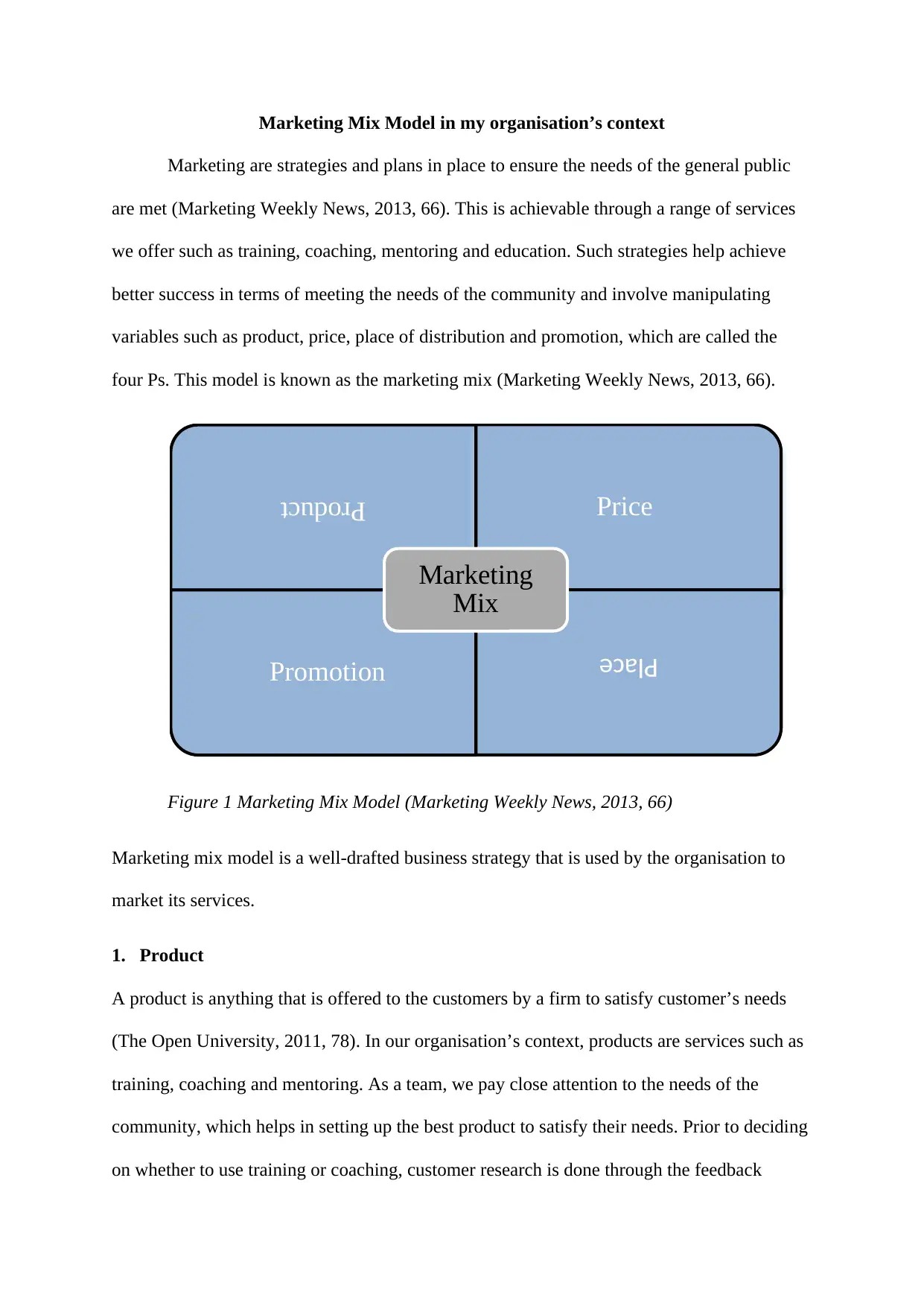
Marketing Mix Model in my organisation’s context
Marketing are strategies and plans in place to ensure the needs of the general public
are met (Marketing Weekly News, 2013, 66). This is achievable through a range of services
we offer such as training, coaching, mentoring and education. Such strategies help achieve
better success in terms of meeting the needs of the community and involve manipulating
variables such as product, price, place of distribution and promotion, which are called the
four Ps. This model is known as the marketing mix (Marketing Weekly News, 2013, 66).
Figure 1 Marketing Mix Model (Marketing Weekly News, 2013, 66)
Marketing mix model is a well-drafted business strategy that is used by the organisation to
market its services.
1. Product
A product is anything that is offered to the customers by a firm to satisfy customer’s needs
(The Open University, 2011, 78). In our organisation’s context, products are services such as
training, coaching and mentoring. As a team, we pay close attention to the needs of the
community, which helps in setting up the best product to satisfy their needs. Prior to deciding
on whether to use training or coaching, customer research is done through the feedback
Product Price
Promotion
Place
Marketing
Mix
Marketing are strategies and plans in place to ensure the needs of the general public
are met (Marketing Weekly News, 2013, 66). This is achievable through a range of services
we offer such as training, coaching, mentoring and education. Such strategies help achieve
better success in terms of meeting the needs of the community and involve manipulating
variables such as product, price, place of distribution and promotion, which are called the
four Ps. This model is known as the marketing mix (Marketing Weekly News, 2013, 66).
Figure 1 Marketing Mix Model (Marketing Weekly News, 2013, 66)
Marketing mix model is a well-drafted business strategy that is used by the organisation to
market its services.
1. Product
A product is anything that is offered to the customers by a firm to satisfy customer’s needs
(The Open University, 2011, 78). In our organisation’s context, products are services such as
training, coaching and mentoring. As a team, we pay close attention to the needs of the
community, which helps in setting up the best product to satisfy their needs. Prior to deciding
on whether to use training or coaching, customer research is done through the feedback
Product Price
Promotion
Place
Marketing
Mix
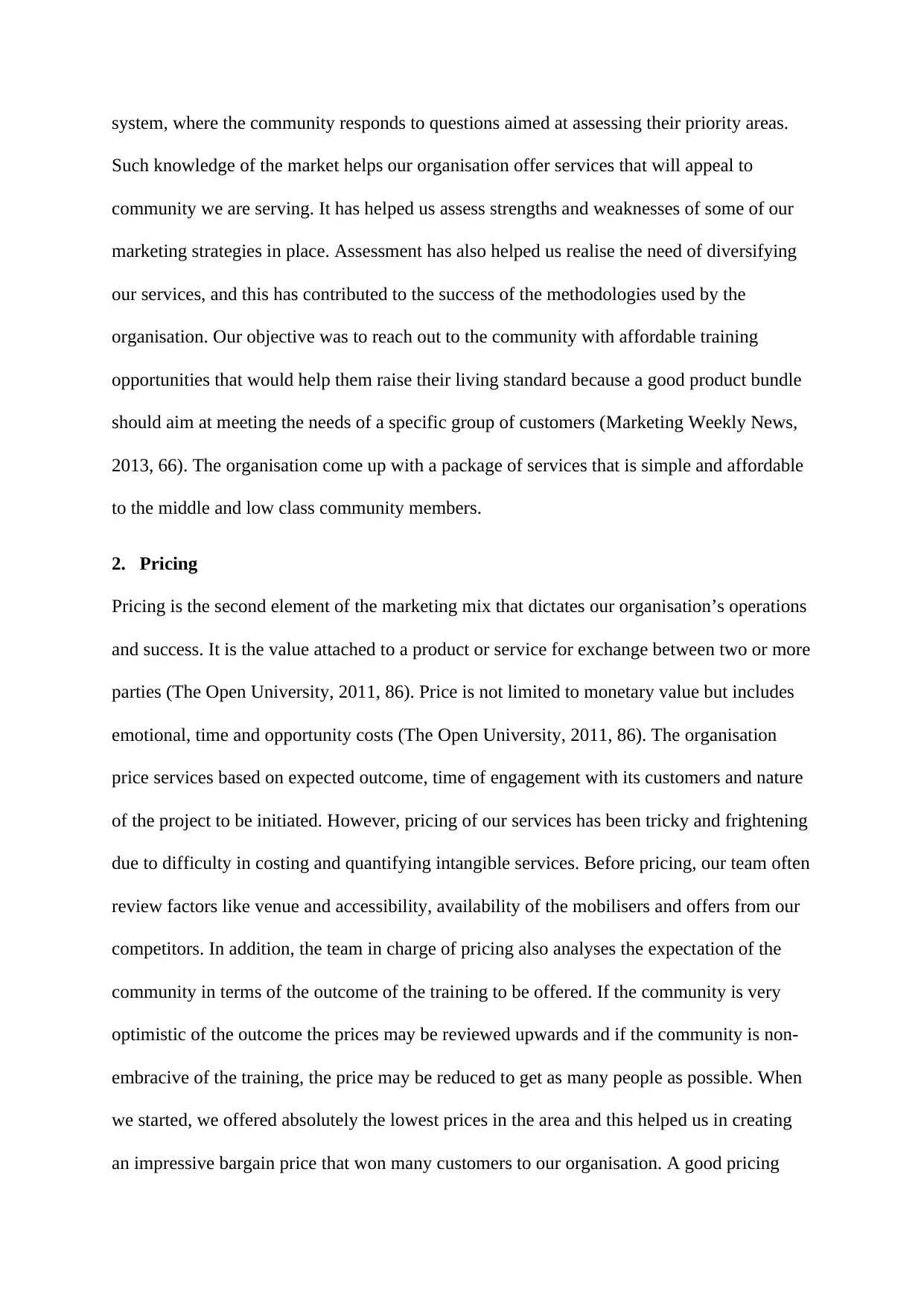
system, where the community responds to questions aimed at assessing their priority areas.
Such knowledge of the market helps our organisation offer services that will appeal to
community we are serving. It has helped us assess strengths and weaknesses of some of our
marketing strategies in place. Assessment has also helped us realise the need of diversifying
our services, and this has contributed to the success of the methodologies used by the
organisation. Our objective was to reach out to the community with affordable training
opportunities that would help them raise their living standard because a good product bundle
should aim at meeting the needs of a specific group of customers (Marketing Weekly News,
2013, 66). The organisation come up with a package of services that is simple and affordable
to the middle and low class community members.
2. Pricing
Pricing is the second element of the marketing mix that dictates our organisation’s operations
and success. It is the value attached to a product or service for exchange between two or more
parties (The Open University, 2011, 86). Price is not limited to monetary value but includes
emotional, time and opportunity costs (The Open University, 2011, 86). The organisation
price services based on expected outcome, time of engagement with its customers and nature
of the project to be initiated. However, pricing of our services has been tricky and frightening
due to difficulty in costing and quantifying intangible services. Before pricing, our team often
review factors like venue and accessibility, availability of the mobilisers and offers from our
competitors. In addition, the team in charge of pricing also analyses the expectation of the
community in terms of the outcome of the training to be offered. If the community is very
optimistic of the outcome the prices may be reviewed upwards and if the community is non-
embracive of the training, the price may be reduced to get as many people as possible. When
we started, we offered absolutely the lowest prices in the area and this helped us in creating
an impressive bargain price that won many customers to our organisation. A good pricing
Such knowledge of the market helps our organisation offer services that will appeal to
community we are serving. It has helped us assess strengths and weaknesses of some of our
marketing strategies in place. Assessment has also helped us realise the need of diversifying
our services, and this has contributed to the success of the methodologies used by the
organisation. Our objective was to reach out to the community with affordable training
opportunities that would help them raise their living standard because a good product bundle
should aim at meeting the needs of a specific group of customers (Marketing Weekly News,
2013, 66). The organisation come up with a package of services that is simple and affordable
to the middle and low class community members.
2. Pricing
Pricing is the second element of the marketing mix that dictates our organisation’s operations
and success. It is the value attached to a product or service for exchange between two or more
parties (The Open University, 2011, 86). Price is not limited to monetary value but includes
emotional, time and opportunity costs (The Open University, 2011, 86). The organisation
price services based on expected outcome, time of engagement with its customers and nature
of the project to be initiated. However, pricing of our services has been tricky and frightening
due to difficulty in costing and quantifying intangible services. Before pricing, our team often
review factors like venue and accessibility, availability of the mobilisers and offers from our
competitors. In addition, the team in charge of pricing also analyses the expectation of the
community in terms of the outcome of the training to be offered. If the community is very
optimistic of the outcome the prices may be reviewed upwards and if the community is non-
embracive of the training, the price may be reduced to get as many people as possible. When
we started, we offered absolutely the lowest prices in the area and this helped us in creating
an impressive bargain price that won many customers to our organisation. A good pricing
⊘ This is a preview!⊘
Do you want full access?
Subscribe today to unlock all pages.

Trusted by 1+ million students worldwide
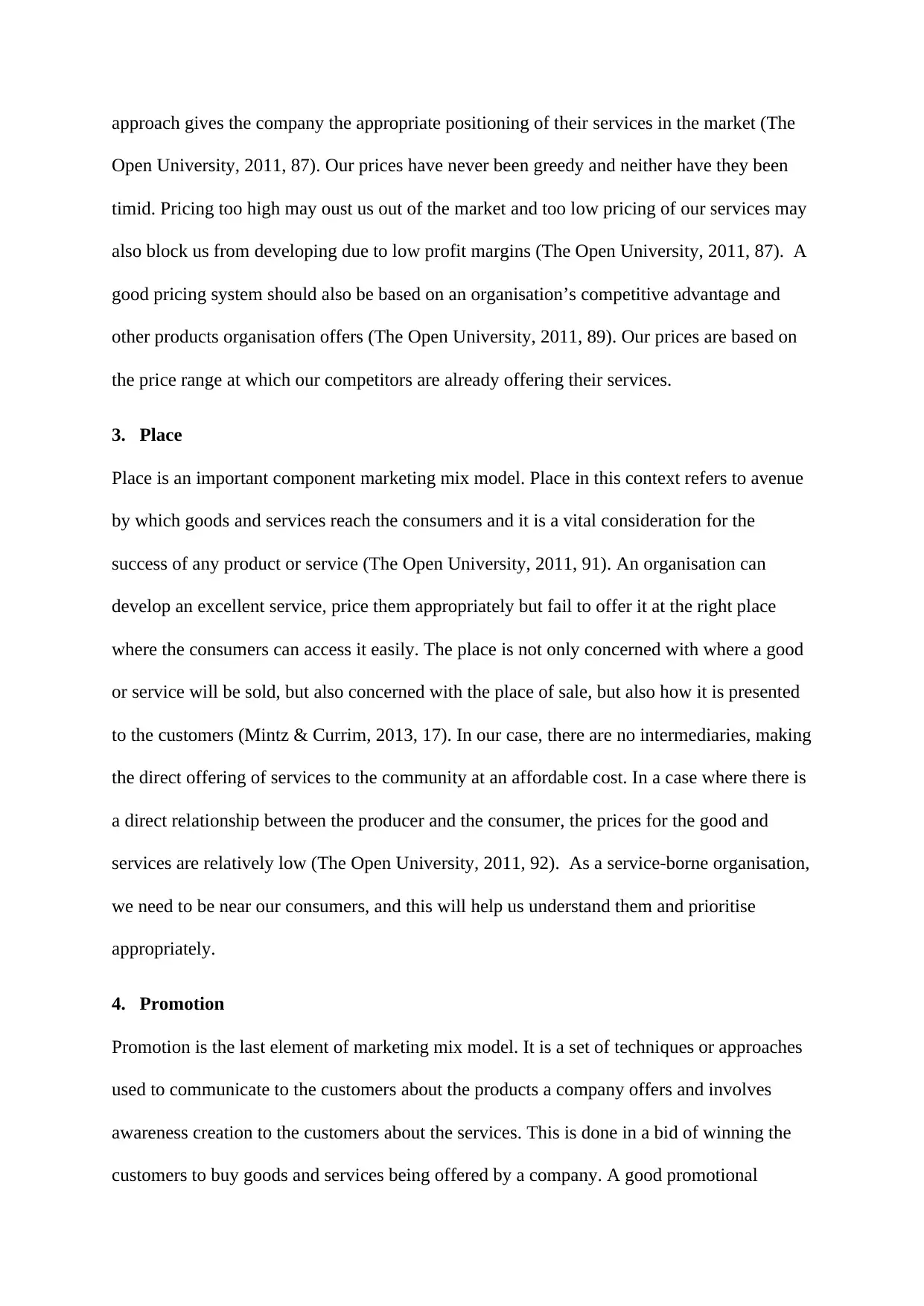
approach gives the company the appropriate positioning of their services in the market (The
Open University, 2011, 87). Our prices have never been greedy and neither have they been
timid. Pricing too high may oust us out of the market and too low pricing of our services may
also block us from developing due to low profit margins (The Open University, 2011, 87). A
good pricing system should also be based on an organisation’s competitive advantage and
other products organisation offers (The Open University, 2011, 89). Our prices are based on
the price range at which our competitors are already offering their services.
3. Place
Place is an important component marketing mix model. Place in this context refers to avenue
by which goods and services reach the consumers and it is a vital consideration for the
success of any product or service (The Open University, 2011, 91). An organisation can
develop an excellent service, price them appropriately but fail to offer it at the right place
where the consumers can access it easily. The place is not only concerned with where a good
or service will be sold, but also concerned with the place of sale, but also how it is presented
to the customers (Mintz & Currim, 2013, 17). In our case, there are no intermediaries, making
the direct offering of services to the community at an affordable cost. In a case where there is
a direct relationship between the producer and the consumer, the prices for the good and
services are relatively low (The Open University, 2011, 92). As a service-borne organisation,
we need to be near our consumers, and this will help us understand them and prioritise
appropriately.
4. Promotion
Promotion is the last element of marketing mix model. It is a set of techniques or approaches
used to communicate to the customers about the products a company offers and involves
awareness creation to the customers about the services. This is done in a bid of winning the
customers to buy goods and services being offered by a company. A good promotional
Open University, 2011, 87). Our prices have never been greedy and neither have they been
timid. Pricing too high may oust us out of the market and too low pricing of our services may
also block us from developing due to low profit margins (The Open University, 2011, 87). A
good pricing system should also be based on an organisation’s competitive advantage and
other products organisation offers (The Open University, 2011, 89). Our prices are based on
the price range at which our competitors are already offering their services.
3. Place
Place is an important component marketing mix model. Place in this context refers to avenue
by which goods and services reach the consumers and it is a vital consideration for the
success of any product or service (The Open University, 2011, 91). An organisation can
develop an excellent service, price them appropriately but fail to offer it at the right place
where the consumers can access it easily. The place is not only concerned with where a good
or service will be sold, but also concerned with the place of sale, but also how it is presented
to the customers (Mintz & Currim, 2013, 17). In our case, there are no intermediaries, making
the direct offering of services to the community at an affordable cost. In a case where there is
a direct relationship between the producer and the consumer, the prices for the good and
services are relatively low (The Open University, 2011, 92). As a service-borne organisation,
we need to be near our consumers, and this will help us understand them and prioritise
appropriately.
4. Promotion
Promotion is the last element of marketing mix model. It is a set of techniques or approaches
used to communicate to the customers about the products a company offers and involves
awareness creation to the customers about the services. This is done in a bid of winning the
customers to buy goods and services being offered by a company. A good promotional
Paraphrase This Document
Need a fresh take? Get an instant paraphrase of this document with our AI Paraphraser
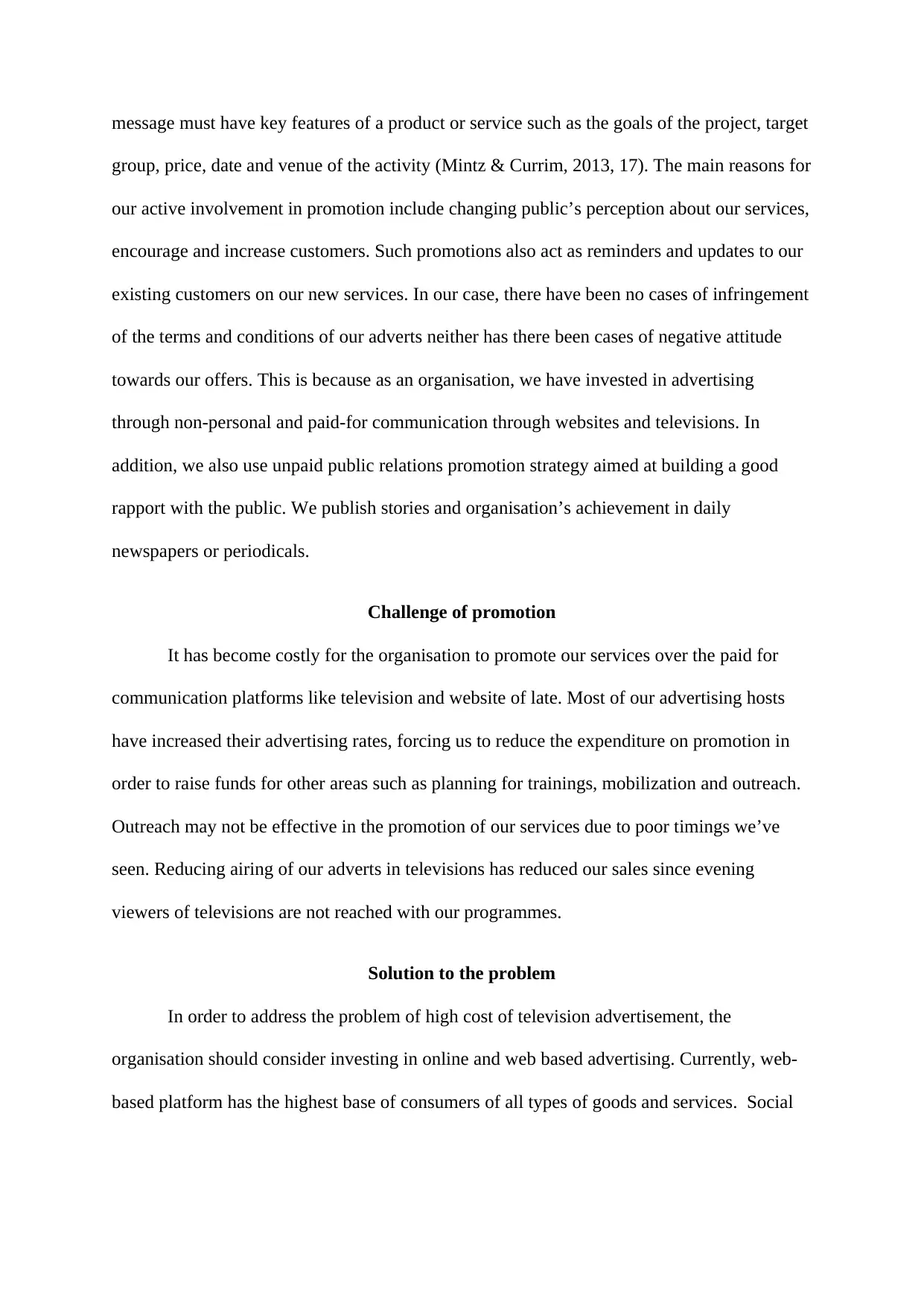
message must have key features of a product or service such as the goals of the project, target
group, price, date and venue of the activity (Mintz & Currim, 2013, 17). The main reasons for
our active involvement in promotion include changing public’s perception about our services,
encourage and increase customers. Such promotions also act as reminders and updates to our
existing customers on our new services. In our case, there have been no cases of infringement
of the terms and conditions of our adverts neither has there been cases of negative attitude
towards our offers. This is because as an organisation, we have invested in advertising
through non-personal and paid-for communication through websites and televisions. In
addition, we also use unpaid public relations promotion strategy aimed at building a good
rapport with the public. We publish stories and organisation’s achievement in daily
newspapers or periodicals.
Challenge of promotion
It has become costly for the organisation to promote our services over the paid for
communication platforms like television and website of late. Most of our advertising hosts
have increased their advertising rates, forcing us to reduce the expenditure on promotion in
order to raise funds for other areas such as planning for trainings, mobilization and outreach.
Outreach may not be effective in the promotion of our services due to poor timings we’ve
seen. Reducing airing of our adverts in televisions has reduced our sales since evening
viewers of televisions are not reached with our programmes.
Solution to the problem
In order to address the problem of high cost of television advertisement, the
organisation should consider investing in online and web based advertising. Currently, web-
based platform has the highest base of consumers of all types of goods and services. Social
group, price, date and venue of the activity (Mintz & Currim, 2013, 17). The main reasons for
our active involvement in promotion include changing public’s perception about our services,
encourage and increase customers. Such promotions also act as reminders and updates to our
existing customers on our new services. In our case, there have been no cases of infringement
of the terms and conditions of our adverts neither has there been cases of negative attitude
towards our offers. This is because as an organisation, we have invested in advertising
through non-personal and paid-for communication through websites and televisions. In
addition, we also use unpaid public relations promotion strategy aimed at building a good
rapport with the public. We publish stories and organisation’s achievement in daily
newspapers or periodicals.
Challenge of promotion
It has become costly for the organisation to promote our services over the paid for
communication platforms like television and website of late. Most of our advertising hosts
have increased their advertising rates, forcing us to reduce the expenditure on promotion in
order to raise funds for other areas such as planning for trainings, mobilization and outreach.
Outreach may not be effective in the promotion of our services due to poor timings we’ve
seen. Reducing airing of our adverts in televisions has reduced our sales since evening
viewers of televisions are not reached with our programmes.
Solution to the problem
In order to address the problem of high cost of television advertisement, the
organisation should consider investing in online and web based advertising. Currently, web-
based platform has the highest base of consumers of all types of goods and services. Social
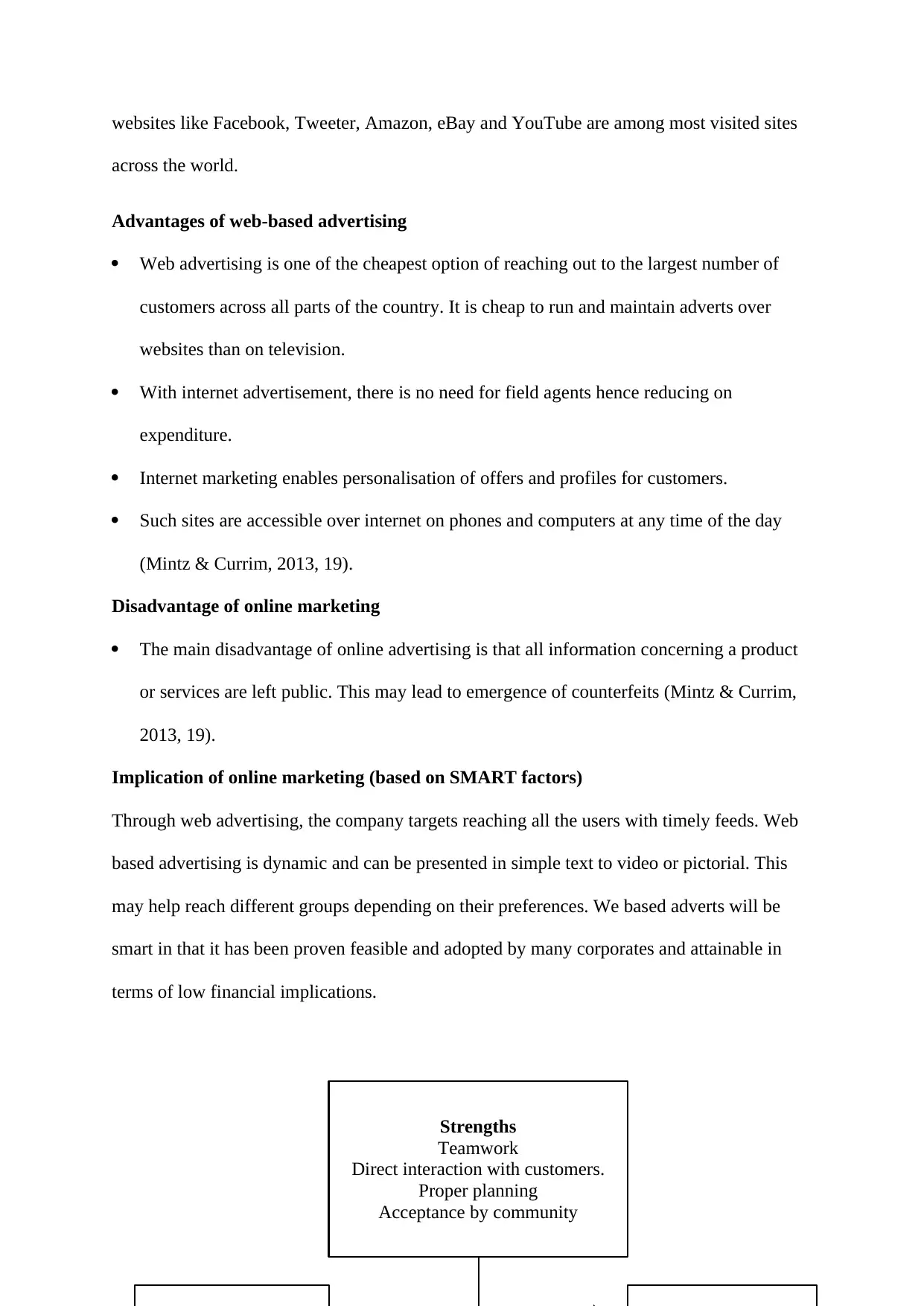
Strengths
Teamwork
Direct interaction with customers.
Proper planning
Acceptance by community
websites like Facebook, Tweeter, Amazon, eBay and YouTube are among most visited sites
across the world.
Advantages of web-based advertising
Web advertising is one of the cheapest option of reaching out to the largest number of
customers across all parts of the country. It is cheap to run and maintain adverts over
websites than on television.
With internet advertisement, there is no need for field agents hence reducing on
expenditure.
Internet marketing enables personalisation of offers and profiles for customers.
Such sites are accessible over internet on phones and computers at any time of the day
(Mintz & Currim, 2013, 19).
Disadvantage of online marketing
The main disadvantage of online advertising is that all information concerning a product
or services are left public. This may lead to emergence of counterfeits (Mintz & Currim,
2013, 19).
Implication of online marketing (based on SMART factors)
Through web advertising, the company targets reaching all the users with timely feeds. Web
based advertising is dynamic and can be presented in simple text to video or pictorial. This
may help reach different groups depending on their preferences. We based adverts will be
smart in that it has been proven feasible and adopted by many corporates and attainable in
terms of low financial implications.
Teamwork
Direct interaction with customers.
Proper planning
Acceptance by community
websites like Facebook, Tweeter, Amazon, eBay and YouTube are among most visited sites
across the world.
Advantages of web-based advertising
Web advertising is one of the cheapest option of reaching out to the largest number of
customers across all parts of the country. It is cheap to run and maintain adverts over
websites than on television.
With internet advertisement, there is no need for field agents hence reducing on
expenditure.
Internet marketing enables personalisation of offers and profiles for customers.
Such sites are accessible over internet on phones and computers at any time of the day
(Mintz & Currim, 2013, 19).
Disadvantage of online marketing
The main disadvantage of online advertising is that all information concerning a product
or services are left public. This may lead to emergence of counterfeits (Mintz & Currim,
2013, 19).
Implication of online marketing (based on SMART factors)
Through web advertising, the company targets reaching all the users with timely feeds. Web
based advertising is dynamic and can be presented in simple text to video or pictorial. This
may help reach different groups depending on their preferences. We based adverts will be
smart in that it has been proven feasible and adopted by many corporates and attainable in
terms of low financial implications.
⊘ This is a preview!⊘
Do you want full access?
Subscribe today to unlock all pages.

Trusted by 1+ million students worldwide
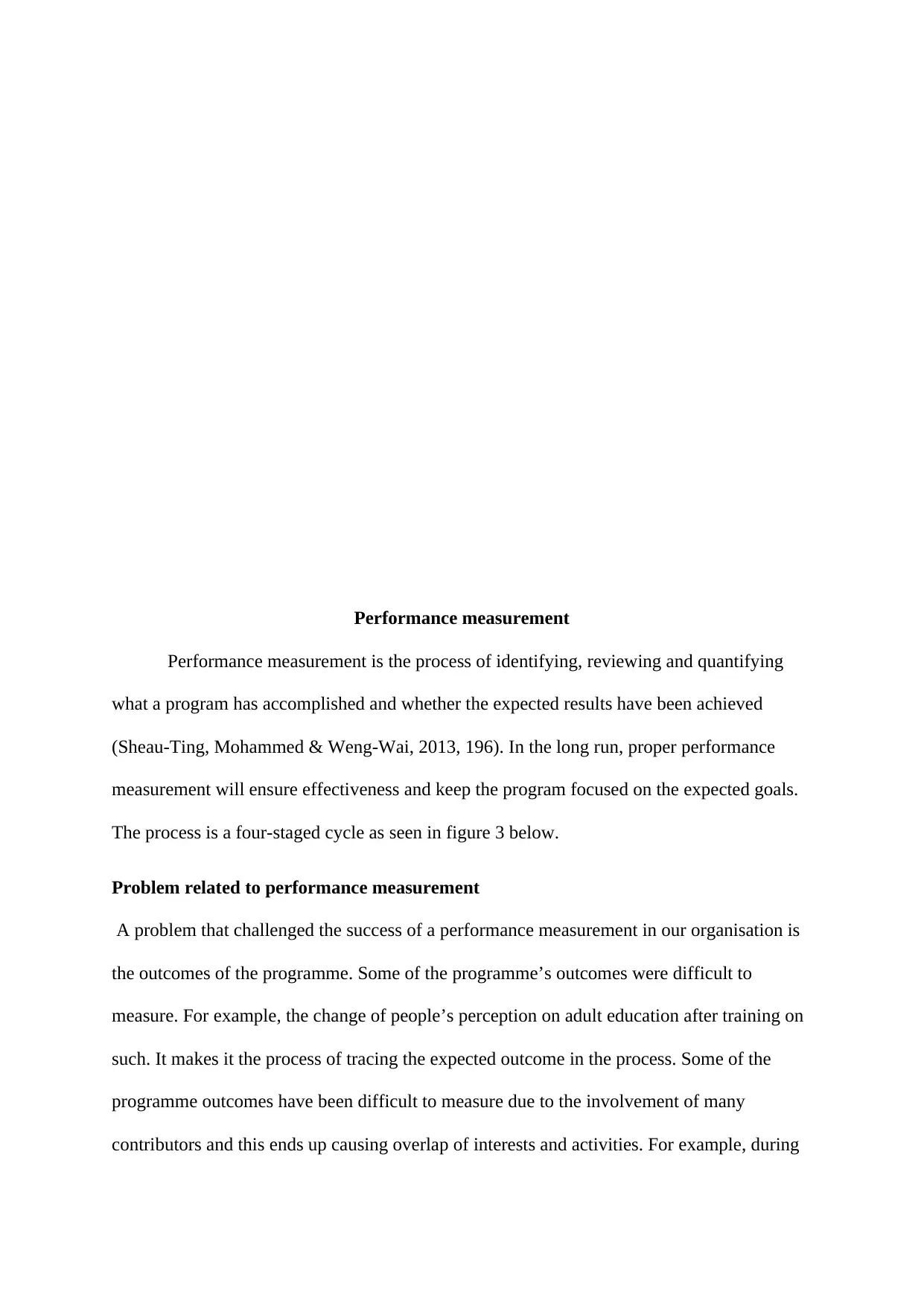
Performance measurement
Performance measurement is the process of identifying, reviewing and quantifying
what a program has accomplished and whether the expected results have been achieved
(Sheau-Ting, Mohammed & Weng-Wai, 2013, 196). In the long run, proper performance
measurement will ensure effectiveness and keep the program focused on the expected goals.
The process is a four-staged cycle as seen in figure 3 below.
Problem related to performance measurement
A problem that challenged the success of a performance measurement in our organisation is
the outcomes of the programme. Some of the programme’s outcomes were difficult to
measure. For example, the change of people’s perception on adult education after training on
such. It makes it the process of tracing the expected outcome in the process. Some of the
programme outcomes have been difficult to measure due to the involvement of many
contributors and this ends up causing overlap of interests and activities. For example, during
Performance measurement is the process of identifying, reviewing and quantifying
what a program has accomplished and whether the expected results have been achieved
(Sheau-Ting, Mohammed & Weng-Wai, 2013, 196). In the long run, proper performance
measurement will ensure effectiveness and keep the program focused on the expected goals.
The process is a four-staged cycle as seen in figure 3 below.
Problem related to performance measurement
A problem that challenged the success of a performance measurement in our organisation is
the outcomes of the programme. Some of the programme’s outcomes were difficult to
measure. For example, the change of people’s perception on adult education after training on
such. It makes it the process of tracing the expected outcome in the process. Some of the
programme outcomes have been difficult to measure due to the involvement of many
contributors and this ends up causing overlap of interests and activities. For example, during
Paraphrase This Document
Need a fresh take? Get an instant paraphrase of this document with our AI Paraphraser
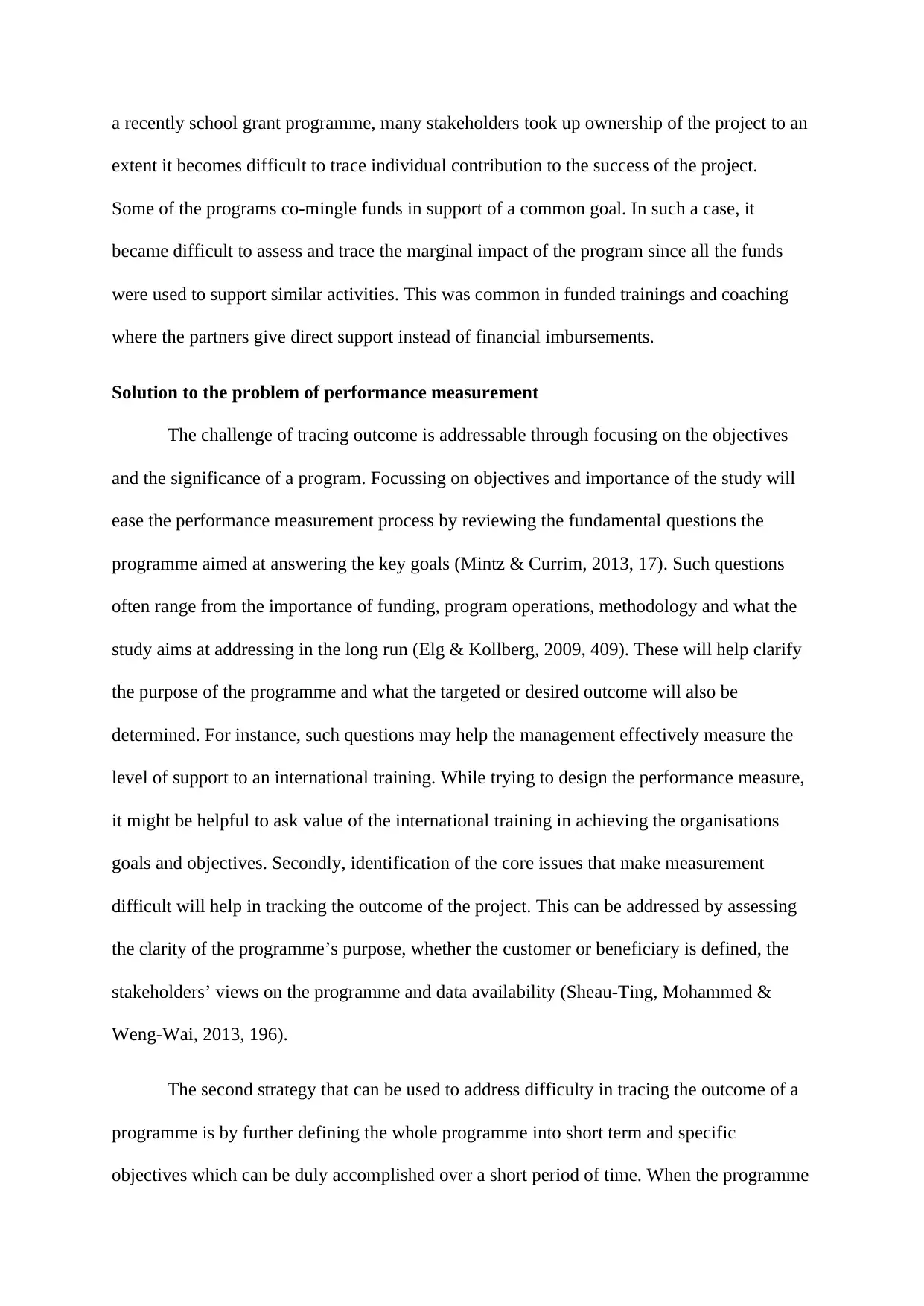
a recently school grant programme, many stakeholders took up ownership of the project to an
extent it becomes difficult to trace individual contribution to the success of the project.
Some of the programs co-mingle funds in support of a common goal. In such a case, it
became difficult to assess and trace the marginal impact of the program since all the funds
were used to support similar activities. This was common in funded trainings and coaching
where the partners give direct support instead of financial imbursements.
Solution to the problem of performance measurement
The challenge of tracing outcome is addressable through focusing on the objectives
and the significance of a program. Focussing on objectives and importance of the study will
ease the performance measurement process by reviewing the fundamental questions the
programme aimed at answering the key goals (Mintz & Currim, 2013, 17). Such questions
often range from the importance of funding, program operations, methodology and what the
study aims at addressing in the long run (Elg & Kollberg, 2009, 409). These will help clarify
the purpose of the programme and what the targeted or desired outcome will also be
determined. For instance, such questions may help the management effectively measure the
level of support to an international training. While trying to design the performance measure,
it might be helpful to ask value of the international training in achieving the organisations
goals and objectives. Secondly, identification of the core issues that make measurement
difficult will help in tracking the outcome of the project. This can be addressed by assessing
the clarity of the programme’s purpose, whether the customer or beneficiary is defined, the
stakeholders’ views on the programme and data availability (Sheau-Ting, Mohammed &
Weng-Wai, 2013, 196).
The second strategy that can be used to address difficulty in tracing the outcome of a
programme is by further defining the whole programme into short term and specific
objectives which can be duly accomplished over a short period of time. When the programme
extent it becomes difficult to trace individual contribution to the success of the project.
Some of the programs co-mingle funds in support of a common goal. In such a case, it
became difficult to assess and trace the marginal impact of the program since all the funds
were used to support similar activities. This was common in funded trainings and coaching
where the partners give direct support instead of financial imbursements.
Solution to the problem of performance measurement
The challenge of tracing outcome is addressable through focusing on the objectives
and the significance of a program. Focussing on objectives and importance of the study will
ease the performance measurement process by reviewing the fundamental questions the
programme aimed at answering the key goals (Mintz & Currim, 2013, 17). Such questions
often range from the importance of funding, program operations, methodology and what the
study aims at addressing in the long run (Elg & Kollberg, 2009, 409). These will help clarify
the purpose of the programme and what the targeted or desired outcome will also be
determined. For instance, such questions may help the management effectively measure the
level of support to an international training. While trying to design the performance measure,
it might be helpful to ask value of the international training in achieving the organisations
goals and objectives. Secondly, identification of the core issues that make measurement
difficult will help in tracking the outcome of the project. This can be addressed by assessing
the clarity of the programme’s purpose, whether the customer or beneficiary is defined, the
stakeholders’ views on the programme and data availability (Sheau-Ting, Mohammed &
Weng-Wai, 2013, 196).
The second strategy that can be used to address difficulty in tracing the outcome of a
programme is by further defining the whole programme into short term and specific
objectives which can be duly accomplished over a short period of time. When the programme
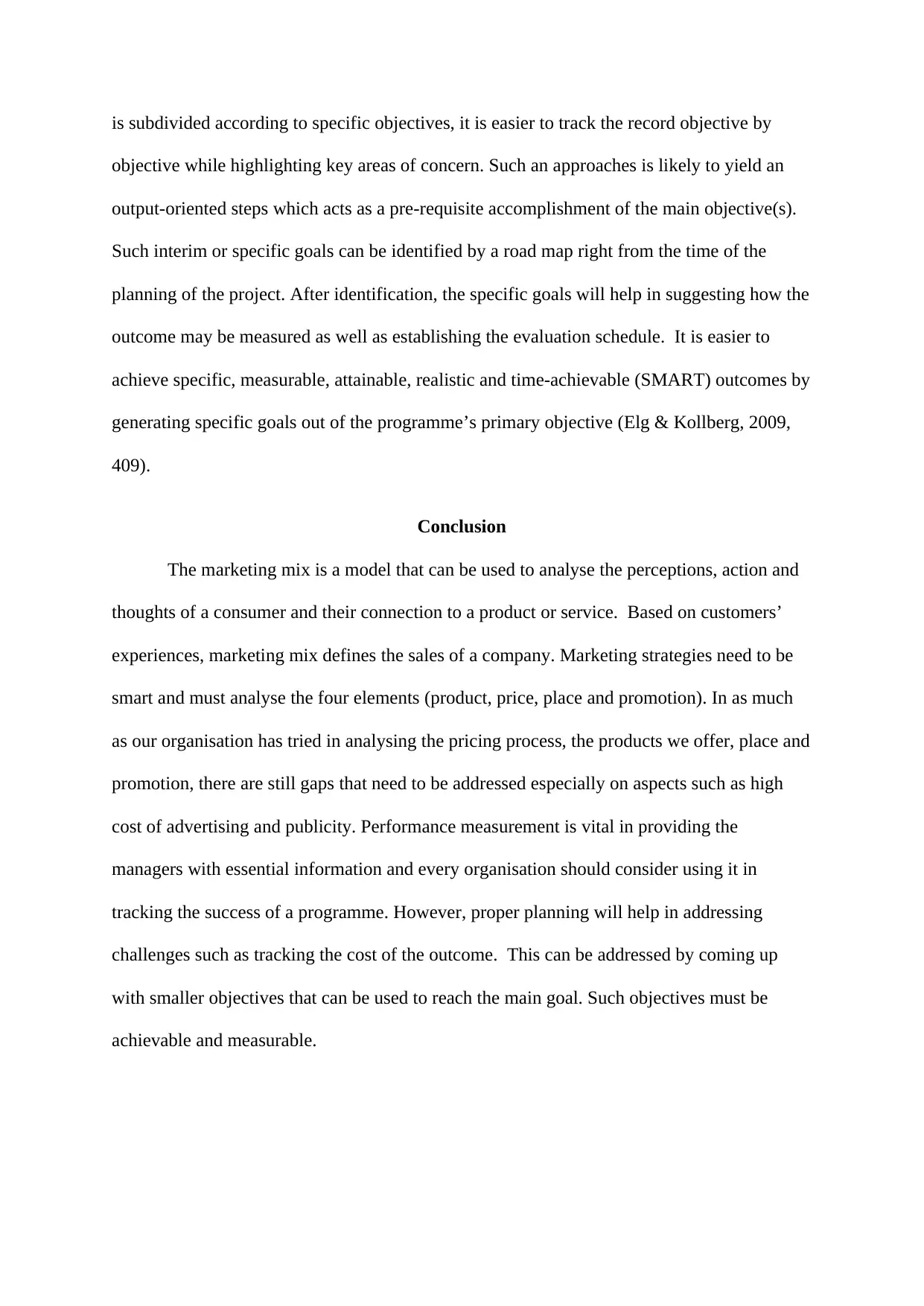
is subdivided according to specific objectives, it is easier to track the record objective by
objective while highlighting key areas of concern. Such an approaches is likely to yield an
output-oriented steps which acts as a pre-requisite accomplishment of the main objective(s).
Such interim or specific goals can be identified by a road map right from the time of the
planning of the project. After identification, the specific goals will help in suggesting how the
outcome may be measured as well as establishing the evaluation schedule. It is easier to
achieve specific, measurable, attainable, realistic and time-achievable (SMART) outcomes by
generating specific goals out of the programme’s primary objective (Elg & Kollberg, 2009,
409).
Conclusion
The marketing mix is a model that can be used to analyse the perceptions, action and
thoughts of a consumer and their connection to a product or service. Based on customers’
experiences, marketing mix defines the sales of a company. Marketing strategies need to be
smart and must analyse the four elements (product, price, place and promotion). In as much
as our organisation has tried in analysing the pricing process, the products we offer, place and
promotion, there are still gaps that need to be addressed especially on aspects such as high
cost of advertising and publicity. Performance measurement is vital in providing the
managers with essential information and every organisation should consider using it in
tracking the success of a programme. However, proper planning will help in addressing
challenges such as tracking the cost of the outcome. This can be addressed by coming up
with smaller objectives that can be used to reach the main goal. Such objectives must be
achievable and measurable.
objective while highlighting key areas of concern. Such an approaches is likely to yield an
output-oriented steps which acts as a pre-requisite accomplishment of the main objective(s).
Such interim or specific goals can be identified by a road map right from the time of the
planning of the project. After identification, the specific goals will help in suggesting how the
outcome may be measured as well as establishing the evaluation schedule. It is easier to
achieve specific, measurable, attainable, realistic and time-achievable (SMART) outcomes by
generating specific goals out of the programme’s primary objective (Elg & Kollberg, 2009,
409).
Conclusion
The marketing mix is a model that can be used to analyse the perceptions, action and
thoughts of a consumer and their connection to a product or service. Based on customers’
experiences, marketing mix defines the sales of a company. Marketing strategies need to be
smart and must analyse the four elements (product, price, place and promotion). In as much
as our organisation has tried in analysing the pricing process, the products we offer, place and
promotion, there are still gaps that need to be addressed especially on aspects such as high
cost of advertising and publicity. Performance measurement is vital in providing the
managers with essential information and every organisation should consider using it in
tracking the success of a programme. However, proper planning will help in addressing
challenges such as tracking the cost of the outcome. This can be addressed by coming up
with smaller objectives that can be used to reach the main goal. Such objectives must be
achievable and measurable.
⊘ This is a preview!⊘
Do you want full access?
Subscribe today to unlock all pages.

Trusted by 1+ million students worldwide
1 out of 13
Related Documents
Your All-in-One AI-Powered Toolkit for Academic Success.
+13062052269
info@desklib.com
Available 24*7 on WhatsApp / Email
![[object Object]](/_next/static/media/star-bottom.7253800d.svg)
Unlock your academic potential
Copyright © 2020–2025 A2Z Services. All Rights Reserved. Developed and managed by ZUCOL.




